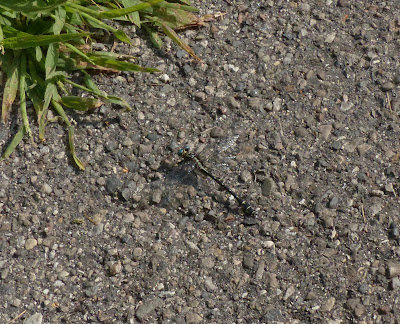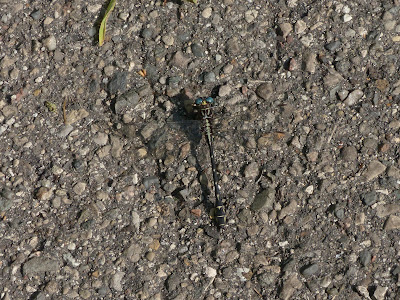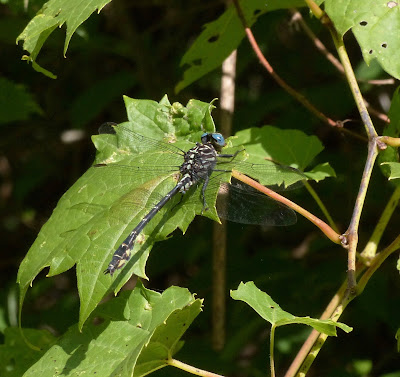Found on the south side of the woodland trail on Sunday, 08/27/17 - my Green Heron day - see my prior blog entry.
But the dragonfly remained in place while I got my camera functioning again.
I could see the clubtail on this dragonfly so I hoped that this would be my first clubtail.
When the dragonfly flew it was only a short distance to some vegetation about 4 feet off the ground. I knew my photos from the asphalt would not be good so this was photo luck.
Once landed on the vegetation, I knew my photos would be much better with the contrast of the dark dragonfly against the bright, green leaves.
I had no idea what it was, but I thought I would be able to easily identify it when I got home.
I looked through the Stokes Beginner's Guide to Dragonflies (2002), a small, handy little book with some of our most common dragonflies. On page 93 there is a nice little sidebar titled "Identifying Clubtails (family Gomphidae)," and I learned that clubtails are actually difficult to identify. In any event, this dragonfly was not in Stokes. Undaunted, I delved into the large clubtail family - more than 100 pages - in Dennis Paulson's Dragonflies and Damselflies of the East (2011) and made an identification that seemed possible - Lilypad Clubtail (Arigomphus furcifer) (page 215) - considering that I was at Belle Isle and the closest lily pads were only about 200 yards away. Even at my novice level there were some troubling details to this ID - the most obvious being that Paulson describes Lilypad Clubtail's cerci as being yellow. My dragonfly's cerci are definitely black. For some reason I remained stuck on my ID.
I love Dennis Paulson's books on dragonflies and damselflies in the East and West and think both greatly contribute to our understanding of odonata; but, in point of fact, many of the photos are not great. It's easy to see why dragonflies can be difficult to identify from photo records only. I submitted the details of this dragonfly with three photos to Odonata Central and identified it as a Lilypad Clubtail.
This afternoon I opened an email from Darrin O'Brien (a reviewer of Michigan submissions to Odonata Central) and learned that not only were my dragonfly's cerci the wrong color, but that Lilypad Clubtails have stopped flying for the season. Further, he wrote that my dragonfly was not a pond species, but a river species and hinted that I had found something much better.
So what is this dragonfly? Out with it already! Elusive Clubtail (Stylurus notatus) (page 280). Darrin's hint came in the following link from the Urban Dragon Hunters blog entry on September 9, 2006. I corrected my entry on Odonata Central and later this evening Darrin emailed the following: "Congrats. Relatively few people see them, thus the common name. The Detroit River area seems to be a decent place to look for them, if one knows where to look."
I emailed back that I got lucky. One of my goals was to see a clubtail this season. At the 11th hour it happened
09/02/2017 addendum: Same individual found again in the same location. Below are photos from the second sighting.




































